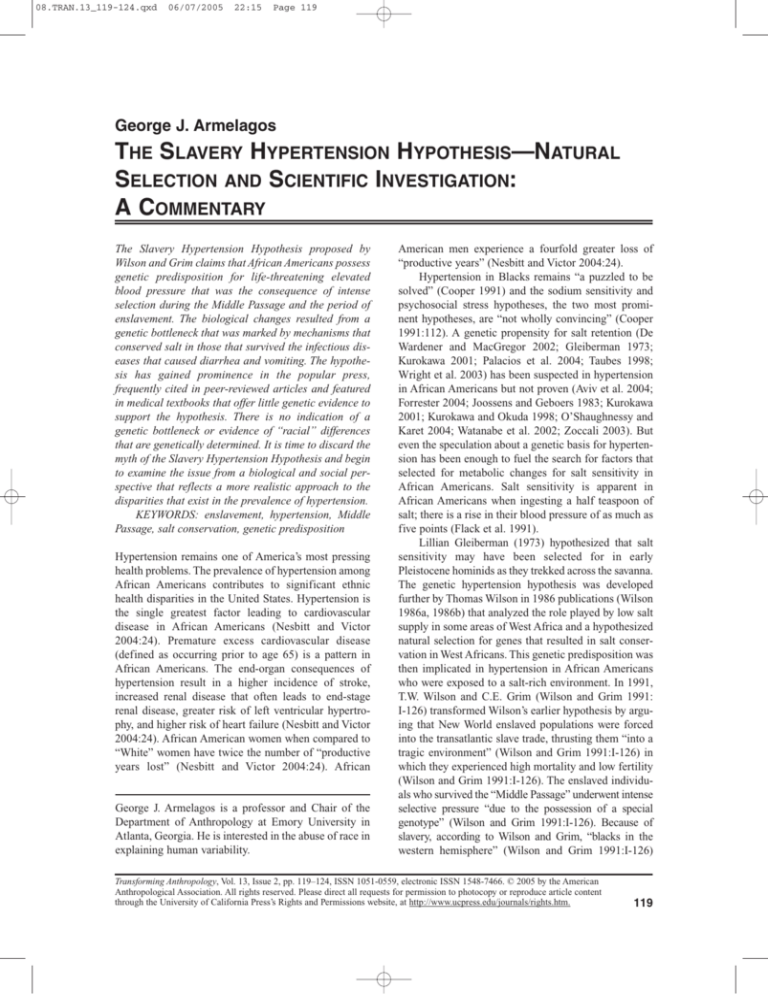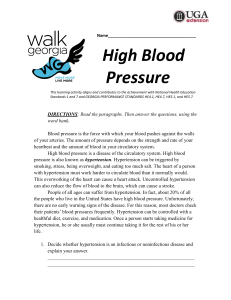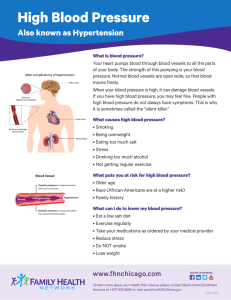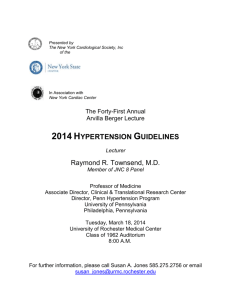
08.TRAN.13_119-124.qxd
06/07/2005
22:15
Page 119
George J. Armelagos
THE SLAVERY HYPERTENSION HYPOTHESIS—NATURAL
SELECTION AND SCIENTIFIC INVESTIGATION:
A COMMENTARY
The Slavery Hypertension Hypothesis proposed by
Wilson and Grim claims that African Americans possess
genetic predisposition for life-threatening elevated
blood pressure that was the consequence of intense
selection during the Middle Passage and the period of
enslavement. The biological changes resulted from a
genetic bottleneck that was marked by mechanisms that
conserved salt in those that survived the infectious diseases that caused diarrhea and vomiting. The hypothesis has gained prominence in the popular press,
frequently cited in peer-reviewed articles and featured
in medical textbooks that offer little genetic evidence to
support the hypothesis. There is no indication of a
genetic bottleneck or evidence of “racial” differences
that are genetically determined. It is time to discard the
myth of the Slavery Hypertension Hypothesis and begin
to examine the issue from a biological and social perspective that reflects a more realistic approach to the
disparities that exist in the prevalence of hypertension.
KEYWORDS: enslavement, hypertension, Middle
Passage, salt conservation, genetic predisposition
Hypertension remains one of America’s most pressing
health problems. The prevalence of hypertension among
African Americans contributes to significant ethnic
health disparities in the United States. Hypertension is
the single greatest factor leading to cardiovascular
disease in African Americans (Nesbitt and Victor
2004:24). Premature excess cardiovascular disease
(defined as occurring prior to age 65) is a pattern in
African Americans. The end-organ consequences of
hypertension result in a higher incidence of stroke,
increased renal disease that often leads to end-stage
renal disease, greater risk of left ventricular hypertrophy, and higher risk of heart failure (Nesbitt and Victor
2004:24). African American women when compared to
“White” women have twice the number of “productive
years lost” (Nesbitt and Victor 2004:24). African
George J. Armelagos is a professor and Chair of the
Department of Anthropology at Emory University in
Atlanta, Georgia. He is interested in the abuse of race in
explaining human variability.
American men experience a fourfold greater loss of
“productive years” (Nesbitt and Victor 2004:24).
Hypertension in Blacks remains “a puzzled to be
solved” (Cooper 1991) and the sodium sensitivity and
psychosocial stress hypotheses, the two most prominent hypotheses, are “not wholly convincing” (Cooper
1991:112). A genetic propensity for salt retention (De
Wardener and MacGregor 2002; Gleiberman 1973;
Kurokawa 2001; Palacios et al. 2004; Taubes 1998;
Wright et al. 2003) has been suspected in hypertension
in African Americans but not proven (Aviv et al. 2004;
Forrester 2004; Joossens and Geboers 1983; Kurokawa
2001; Kurokawa and Okuda 1998; O’Shaughnessy and
Karet 2004; Watanabe et al. 2002; Zoccali 2003). But
even the speculation about a genetic basis for hypertension has been enough to fuel the search for factors that
selected for metabolic changes for salt sensitivity in
African Americans. Salt sensitivity is apparent in
African Americans when ingesting a half teaspoon of
salt; there is a rise in their blood pressure of as much as
five points (Flack et al. 1991).
Lillian Gleiberman (1973) hypothesized that salt
sensitivity may have been selected for in early
Pleistocene hominids as they trekked across the savanna.
The genetic hypertension hypothesis was developed
further by Thomas Wilson in 1986 publications (Wilson
1986a, 1986b) that analyzed the role played by low salt
supply in some areas of West Africa and a hypothesized
natural selection for genes that resulted in salt conservation in West Africans. This genetic predisposition was
then implicated in hypertension in African Americans
who were exposed to a salt-rich environment. In 1991,
T.W. Wilson and C.E. Grim (Wilson and Grim 1991:
I-126) transformed Wilson’s earlier hypothesis by arguing that New World enslaved populations were forced
into the transatlantic slave trade, thrusting them “into a
tragic environment” (Wilson and Grim 1991:I-126) in
which they experienced high mortality and low fertility
(Wilson and Grim 1991:I-126). The enslaved individuals who survived the “Middle Passage” underwent intense
selective pressure “due to the possession of a special
genotype” (Wilson and Grim 1991:I-126). Because of
slavery, according to Wilson and Grim, “blacks in the
western hemisphere” (Wilson and Grim 1991:I-126)
Transforming Anthropology, Vol. 13, Issue 2, pp. 119–124, ISSN 1051-0559, electronic ISSN 1548-7466. © 2005 by the American
Anthropological Association. All rights reserved. Please direct all requests for permission to photocopy or reproduce article content
through the University of California Press’s Rights and Permissions website, at http://www.ucpress.edu/journals/rights.htm.
119
08.TRAN.13_119-124.qxd
06/07/2005
22:15
Page 120
may be different from “today’s blacks in Africa”
(Wilson and Grim 1991:I-126). The high mortality during
the Middle Passage followed by the period of enslavement
was caused “largely by salt- and water-depletive diseases”
(Wilson and Grim 1991:I-126) resulting in a genetic
change in sodium metabolism (Wilson and Grim
1991:I-126). This “enhanced genetic-based ability to
conserve salt” (Wilson and Grim 1991:I-122) is more
prevalent among “western hemisphere blacks than
among African blacks” (Wilson and Grim 1991:I-126)
and may have subsequently resulted in a higher prevalence of hypertension in African Americans.
There is one assumption and three lines of evidence
that are used to support their hypothesis. While Wilson
and Grim (1991:I-125) cite Grollmann’s (1978) observation that the hypothesis is “impossible to verify,” they
believed that the extensive information now available on
the “biohistory of blacks” (Wilson and Grim 1991:I-125)
made it possible to test the hypothesis. They started with
an assumption that early Paleolithic hominids living in a
hot and salt-depleted savanna environment evolved an
ability to conserve salt (Gleiberman 1973). This scenario assumes that water was conserved because of
excessive sweating (Newman 1970). First, “Blacks,”
Wilson and Grim claim, are more sensitive to salt, with
an enhanced genetic ability to retain sodium. Initially,
Wilson and Grim saw this as a problem with “defective
kidneys” (Wilson and Grim 1991:I-123) and “renal
defects that could not excrete salt effectively” (Wilson
and Grim 1991:I-123). Second, the high mortality during
the Middle Passage was due to “conditions that ultimately kill by salt and water depletion” (Wilson and
Grim 1991:I-125). Vomiting, sweating, and diarrheal
diseases were causes of sodium depletion during the
Middle Passage. Third, high mortality during the period
of enslavement continued to select for sodium retention
because of intensive heat and punishing physical labor
(Wilson and Grim 1991:I-125–I-126).
Fatimah L.C. Jackson (1991) supported the argument for the selection for salt retention during the
Middle Passage.1 She believed that this intense selective
mortality resulted in a genetic bottleneck (a constriction
of existing genetic variability [Poston et al. 2001]) for
salt conservation. She offers an interesting addition to
the Wilson-Grim hypothesis by suggesting that the
stress experienced by enslaved populations may have
increased genetic variability. Using experimental evidence from drosophila that suggests environmental
stress as a mechanism for increasing genetic variation,
she argues that there would have been a “burst” of point
mutations and an increase in genetic recombination that
would increase variability in populations that survived
the Middle Passage. Even if there was this unlikely
“burst” of diversity in enslaved populations, there should
120
TRANSFORMING ANTHROPOLOGY 2005 VOL. 13 (2)
be evidence of salt conservation in the descendants that
survived the Middle Passage. A recent genetic analysis
(Poston et al. 2001) in a sample of U.S.-born African
Americans and African-born immigrants used alleles
associated with hypertension risk (G-protein, AGT-235,
and ACE I/D) to test for evidence of a genetic bottleneck in U.S.-born African Americans that would
support the Slavery Hypertension Hypothesis. In fact,
the research showed an association of the AGT-235
homozygous T genotype with African-born immigrants.
This finding counters the notion of a bottleneck in the
survivors of the Middle Passage.
The renowned historian Phillip D. Curtin (1992)
provides a devastating analysis of Wilson and Grim’s
logic as well as the demographics and historical data
used to bolster their argument. Curtin (1992:1686) evaluates Wilson and Grim’s arguments by saying that the
Slavery Hypertension Hypothesis lacks supporting evidence and “runs counter to what evidence we do have.”
Curtin questioned Wilson and Grim’s use of “African
American” as a biological marker (Curtin 1992:1681);
their misuse of historical sources (Curtin 1992:1683);
the size of enslaved population transported during the
Middle Passage (Curtin 1992:1683); the cause and the
rates of mortality during the Middle Passage (Curtin
1992:1684); the availability of salt on the slave ships
(Curtin 1992:1682); the misinterpretation of his
(Curtin’s) accounts of the slave trade, miscalculating the
availability of salt in Africa (Curtin 1992:1682); and the
failure to describe the salt trade (Curtin 1992:1682).
Furthermore, Curtin notes that the popularization of
this story (Diamond 1991) both selectively misrepresents the evidence (Curtin 1992:1684) from Wilson
and Grim and presents the hypothesis as proven.
Publications that use data to distort reality increase the
gap between scientific and historical knowledge, and
this concerns Curtin (1992:1686).
The popularization of the Slavery Hypertension
Hypothesis (Kaufman and Hall 2003a, 2003b) is evident
in how it was reported extensively in the newspaper,
magazines (Diamond 1991), and review articles that
appear in medical journals and textbooks. For example,
Joel E. Dimsdale (2000) in “Stalked by the Past,” his
presidential address to the American Psychosomatic
Society, describes how our biological past influences the
health of contemporary ethnic groups. Dimsdale
(2000:164) uses the relationship between salt and slavery as one of his prime example of how the past stalks
the present. Building on his earlier research (Dimsdale
et al. 1990) on salt ingestion in four groups (Blacks,
Whites, normotensives, and hypertensives), Dimsdale
and colleagues found that “salt sensitivity was found in
only one group of individuals—black hypertensives.”
While noting that the genetic basis for salt sensitivity
08.TRAN.13_119-124.qxd
06/07/2005
22:15
Page 121
has reached little consensus, he nevertheless claims that
there are “unique historical sources” (Dimsdale
2000:165) to support the Slavery Hypertension
Hypothesis. Using the arguments derived from Wilson
and Grim (1991), Dimsdale repeats the Slavery
Hypertension story, saying that those who survived
enslavement “would be less likely to sustain lethal
electrolyte abnormalities” (Dimsdale 2000:165). While
he describes the Slavery Hypertension Hypothesis as
“sheer speculation because, to date, the frequency of
alleles—at least for the renin-angiotensin system—is
similar in Blacks from West Africa and the United
States, nevertheless the hypothesis remains an intriguing one” (Dimsdale 2000:165). He then quotes a
passage from Moby Dick describing sharks trailing
slave ships (Dimsdale 2000:165), scavenging the bodies
thrown overboard. He also describes a 1794 engraving
in which a slave trader is licking the cheek of an “African
captive” to taste his sweat (Dimsdale 2000:166).
Dimsdale claims that this illustrates a test to determine
if the sweat was salty, which would indicate an inability
to conserve salt and making it less likely that the enslaved individual would be able to survive the Middle
Passage. Dimsdale is quick to point out that these
assertions are difficult to evaluate because of the “distance of time” but are suggestive “of a genetic legacy
from the middle passage, a historical legacy accounting
for increased salt retention and thereby accounting for
increased salt retention and thereby increased salt
sensitivity in blacks” (Dimsdale 2000:166).
Kaufman (2001) was quick to respond to
Dimsdale’s results, saying that his analysis was a “careless repetition” of the old “slavery hypothesis” yarn.
Dimsdale (2001) defends the details of his assessment,
saying that his mortality estimates and the use of contemporary evidence from Melville’s description of
sharks trailing slave ships support the validity of the
“slavery hypothesis.” He admonishes Kaufman’s criticism as a politicalization of the issue. Dimsdale states,
“Race and ethnicity are too important to be ignored or
politicized.” Lillian Gleiberman (Gleiberman and
Dimsdale 2001) supports Dimsdale’s interpretation,
saying it exemplifies the “ideas and principle of
Darwinian medicine and it is important for these ideas
to move into the mainstream of medical research”
(Nesse and Williams 1994). While she sees the hypothesis as “intriguing,” she also notes that the genotype
frequencies for the rennin-angiotensin system are similar for West Africans in the African Americans in the
United States. If the African American descendants of
enslaved populations went through the Middle Passage,
they should show differences in genotype frequencies.
Kaufman and Hall (2003a) continued a frontal
attack on the Slavery Hypertension Hypothesis. They
discuss in detail the “career” of the hypothesis from its
presentation at national meetings in 1989 and 1990 to
the single peer-reviewed publication (Wilson and Grim
1991) and two decades of publication in book chapters,
textbooks, and popular press. They are especially concerned with the lack of experimental evidence that supports the Slavery Hypertension Hypothesis. In fact,
there appears to be nearly an inverse relationship
between the reports in the popular press and a definitive
scientific finding that supports the Slavery Hypertension
Hypothesis. Kaufman and Hall show how the language
used in these popular treatments contributes to a notion
that “Blacks” are inherently different by harboring
genetic defects or physiological abnormalities (Kaufman
and Hall 2003a). While terms such as “defective
kidneys” (Wilson and Grim 1991:I-123) and “renal
defects” (Wilson and Grim 1991:I-123) have been
disavowed, Kaufman and Hall (2003a) describe titles in
medical journals that present hypertension in Blacks as a
different disease (Meggs 1985) and as “a paradigm of
metabolic disarray” (Weir and Hanes 1996). Descriptions
such as these essentialize race and present an image of
Blacks as being fundamentally different in their genetic
makeup and that this increases their risk for disease. The
Slavery Hypertension Hypothesis reinforces “notions of
genetic determinism” (Kaufman and Hall 2003a) and the
“essential black abnormality” (Kaufman and Hall 2003a)
that blames the victim and displaces economic or cultural
factors from our understanding of the underlying etiology of the disease process.
Kaufman and Hall’s criticism that Grim and
Robinson essentialize race was interpreted by Grim and
Robinson as their being called racist (Grim and Robinson
2003). Racism was never used or implied in any of the
discussion. In their continuing defense of the Slavery
Hypertension Hypothesis, Grim and Robinson (2003) cite
more demographic evidence that enumerates the mortality involved in the process of enslavement. While they
claim to be testing a hypothesis, their approach reflects a
strategy of advocacy to make their case by marshaling
more evidence about the impact of the Middle Passage. A
primary problem is that they avoid the essential point of
defining a racial (genetic) difference in hypertension risk
among African Americans. This point is brought home
when they ask the question, “Do African populations
metabolize sodium differently than Europeans or African
Americans?”; they answer, “We do not know.” Any scientific test should begin with evidence that there is a genetic
difference in salt sensitivity that is differentially distributed among African Americans before hypothesizing
its cause.
Grim and Robinson claim that Kaufman and Hall
are suggesting that any genetic research that would
demonstrate group difference should cease. Following
GEORGE J. ARMELAGOS
121
08.TRAN.13_119-124.qxd
06/07/2005
22:15
Page 122
Risch et al. (2002), they claim that categorization by
race is a useful tool in biomedical research. While the
use of race as a biological variable in biomedicine
has been challenged (CDC 1993; Cooper et al. 2003;
Geiger 1997; Goodman 2000; Pearce et al. 2004;
South-Paul 2001; Williams and Warren 1994) and supported (Burchard et al. 2003; Dimsdale 2000; Polednak
1989; Risch et al. 2002), its use continues. One of the
problems with analyses that demonstrate a disease risk
in a racial group is that researchers “quit early.” They
assume that race explains the risk and do not attempt to
tease out the social and biological factors that underlie
the association.
In his commentary on Kaufman and Hall’s discussion, K.M. Weiss (2003:124), borrowing from Swiss
jurisprudence, says that “until given a rigorous test” the
verdict on the Slavery Hypertension Hypothesis should
be “judged plausible, but not proven by reason of
doubt.” He acknowledges that there is abundant evidence that African American populations are more susceptible to hypertension than individuals in “other
ethnic groups” are and suggests that this genetic hypothesis may “have the legs [it does] because at best
there is no consensus that such patterns can be entirely
accounted for by differences in environmental exposure.” The first step should be establishing a genetic
relationship in salt sensitivity and hypertension in
African American before perpetuating the Slavery
Hypertension Hypothesis. It also begs the question why
racial explanations are given primacy. Since the genetic
evidence has been problematic, why not give “legs” to
environmental factors in hypertension in African
Americans?
Henry Blackburn (2003) notes that the “ethnic
paradigm” has not been helpful in explaining population differences in hypertension and that “social
epidemiological models remain confounded.” He
comments that while the “Slavery Hypothesis of
Hypertension” is speculative, it may not be any more
speculative than looking at today’s health risks as the
result of rapid change in face of the inertia built into the
genetic legacy developed during the Paleolithic.
Evolutionary medicine, Blackburn argues, provides a
“fresh view of many common afflictions of modern
society” (Blackburn 2003:118), and he implies that to
be critical of that endeavor may inhibit innovative ideas.
Darwinian or evolutionary medicine is not immune to
criticism. The hyperadaptive perspective of Darwinian
medicine often obscures long-term evolutionary
processes by focusing on short-term adaptation
(Armelagos 1997). When the evidence to support “just
so stories” is shown to be inadequate, the importance of
any evolutionary explanations will be minimized.
122
TRANSFORMING ANTHROPOLOGY 2005 VOL. 13 (2)
There is a political aspect to the debate. Blackburn
(2003) says that there are differences in worldviews of
scientist and physicians who see the uniqueness of individuals or races and those who see “vast commonalities” in Homo sapiens. Blackburn finds equating the
uniqueness of an individual and a race to be a similar
phenomenon. Individuals are unique. Races are arbitrary classifications that have limited explanatory
power. Dimsdale (2001:325) see this as an even more
political act and describes critics of the Slavery
Hypertension Hypothesis as “left-thinking people.”
Kaufman and Hall’s (2003b) rebuttal argues that the
politicalization of the issue misses the point. They argue
that they are trying to encourage scientific consensus,
which should be based on “evidence rather than mere
assertion.” Blackburn (2003) suggests that we need
to cool the “temperature” and lower the “temper” to
develop some resolution to the problem.
Cooper (1991:112) notes that blood pressure
control is a highly redundant system that involves
cardiovascular, renal, endocrine, and neural systems.
Therefore, unraveling the ethnic component of such a
complex system is a “daunting” undertaking. It may be
time to take on the “daunting” task of unraveling the
genetic and social factors of hypertension in African
American and other groups. Discarding the Slavery
Hypertension Hypothesis may be the first step in our
efforts to understand this important health disparity. If
genetic racial differences are found in African
Americans with respect to a “hypertension” gene, then
the Slavery Hypertension Hypothesis can be raised
from its grave.
NOTES
Acknowledgments: I would like to thank Peter J. Brown,
Kenneth Maes, and Alan H. Goodman for their thoughtful comments on this article.
1. Kaufman and Hall claim that Jackson is critical
of Wilson and Grim’s hypothesis. In actuality she supports the hypothesis by claiming a bottleneck occurred,
but she suggests that the bottleneck was obscured by
her dubious argument that stress-induced genetic
change increased the variability in African Americans.
REFERENCES CITED
Armelagos, George J.
1997 Disease, Darwin and Medicine in the Third
Epidemiological Transition. Evolutionary
Anthropology 5(6):212–220.
Aviv, A., N.K. Hollenberg, and A. Weder
2004 Urinary potassium excretion and sodium
sensitivity in blacks. Hypertension 43(4):
707–713.
08.TRAN.13_119-124.qxd
06/07/2005
22:15
Page 123
Blackburn, H.
2003 Commentary: The Slavery Hypothesis of
Hypertension among African-Americans.
Epidemiology 14(1):118–119.
Burchard, Esteban González, et al.
2003 The Importance of Race and Ethnic Background in Biomedical Research and Clinical
Practice. New England Journal of Medicine
348(12):1170–1175.
CDC, Centers for Disease Control and Prevention
1993 Use of Race and Ethnicity in Public Health
Surveillance. Summary for the CDC/ATSDR
Workshop. MMWR 42(RR-10):1–17.
Cooper, R.S.
1991 Hypertension in Blacks—A Puzzle Waiting to
Be Solved [comment]. Ethnicity & Disease
1(2):111–113.
Cooper, Richard S., Jay Kaufman, and Ryk Ward
2003 Race and Genomics. New England Journal of
Medicine 348(12):1166–1170.
Curtin, P.D.
1992 The Slavery Hypothesis for Hypertension
among African Americans: The Historical
Evidence. American Journal of Public Health
82(12):1681–1686.
De Wardener, H.E., and G.A. MacGregor
2002 Sodium and Blood Pressure. Current Opinion
in Cardiology 17(4):360–367.
Diamond, Jared
1991 The Saltshaker’s Curse. Natural History
Magazine, October: 20–26.
Dimsdale, J.E.
2000 Stalked by the Past: The Influence of Ethnicity
on Health [see comment] [erratum appears in
Psychosomatic Medicine 62(3):308]. Psychosomatic Medicine 62(2):161–170.
Dimsdale, J.E., M. Ziegler, P. Mills, and C. Berry
1990 Prediction of Salt Sensitivity. American
Journal of Hypertension 3(6 Pt 1):
429–435.
Dimsdale, Joel E.
2001 No More “Slavery Hypothesis” Yarns:
Response. Psychosomatic Medicine 63(2):
325–337.
Flack, J.M., K.E. Ensrud, S. Mascioli, C.A. Launer,
K. Svendsen, P.J. Elmer, and R.H. Grimm, Jr.
1991 Racial and Ethnic Modifiers of the Salt-Blood
Pressure Response. Hypertension 17(1 Suppl):
I-115–I-121.
Forrester, T.
2004 Historic and Early Life Origins of Hypertension in Africans. Journal of Nutrition 134(1):
211–216.
Geiger, H.J.
1997 Annotation: Racism Resurgent—Building a
Bridge to the 19th Century. American Journal
of Public Health 87:1765–1766.
Gleiberman, L.
1973 Blood Pressure and Dietary Salt in Human
Population. Ecology of Food and Nutrition
1:143–156.
Gleiberman, Lillian, and Joel E. Dimsdale
2001 Salt, Hypertension, Evolution Response.
Psychosomatic Medicine 63(2):325–327.
Goodman, Alan H.
2000 Why Genes Don’t Count (For Racial Differences in Health). American Journal of Public
Health 90(11):1699–1702.
Grim, C.E., and M. Robinson
2003 Commentary: Salt, Slavery and Survival—
Hypertension in the African Diaspora. Epidemiology 14(1):120–122.
Grollmann, A.
1978 A Conjecture about the Prevalence of Essential Hypertension and Its High Incidence in
the Black. Texas Reports on Biology and
Medicine 36:25–32.
Jackson, F.L.C.
1991 An Evolutionary Perspective on Salt, Hypertension, and Human Genetic Variability.
Hypertension 17(1):I-129–I-132.
Joossens, J.V., and J. Geboers
1983 Salt and Hypertension. Preventive Medicine
12(1):53–59.
Kaufman, J.S.
2001 No More “Slavery Hypothesis” Yarns [comment]. Psychosomatic Medicine 63(2):324–325.
Kaufman, J.S., and S.A. Hall
2003a The Slavery Hypertension Hypothesis: Dissemination and Appeal of a Modern Race
Theory. Epidemiology 14(1):111–118.
2003b The Slavery Hypertension Hypothesis: The
Authors Respond. Epidemiology 14(1):124–126.
Kurokawa, K.
2001 Salt, Kidney and Hypertension: Why and
What to Learn from Genetic Analyses.
Nephron 89(4):369–376.
Kurokawa, K., and T. Okuda
1998 Genetic and Non-genetic Basis of Essential
Hypertension: Maladaptation of Human Civilization to High Salt Intake. Hypertension
Research—Clinical & Experimental 21(2):67–71.
Meggs, L.G.
1985 Hypertension in Blacks: Is It a Different Disease? New York State Journal of Medicine
85:160–161.
GEORGE J. ARMELAGOS
123
08.TRAN.13_119-124.qxd
06/07/2005
22:15
Page 124
Nesbitt, S., and R.G. Victor
2004 Pathogenesis of Hypertension in African
Americans. Congestive Heart Failure 10(1):
24–29.
Nesse, Randolph M., and George C. Williams
1994 Why We Get Sick: The New Science of
Darwinian Medicine. New York: Times Books.
Newman, R.
1970 Why Is Man Such a Sweaty and Thirsty Naked
Animal? Human Biology 42:12–27.
O’Shaughnessy, K.M., and F.E. Karet
2004 Salt Handling and Hypertension. Journal of
Clinical Investigation 113(8):1075–1081.
Palacios, C., K. Wigertz, B.R. Martin, L. Jackman,
J.H. Pratt, M. Peacock, G. McCabe, and C.M. Weaver
2004 Sodium Retention in Black and White Female
Adolescents in Response to Salt Intake. Journal of Clinical Endocrinology & Metabolism
89(4):1858–1863.
Pearce, Neil, Sunia Foliaki, Andrew Sporle, and
Chris Cunningham
2004 Genetics, Race, Ethnicity, and Health. British
Medical Journal 328(7447):1070–1072.
Polednak, A.P.
1989 Racial and Ethnic Differences in Disease.
New York: Oxford University Press.
Poston, W.S., V.N. Pavlik, D.J. Hyman, K. Ogbonnaya,
C.L. Hanis, C.K. Haddock, M.L. Hyder, and
J.P. Foreyt
2001 Genetic Bottlenecks, Perceived Racism, and
Hypertension Risk among African Americans
and First-Generation African Immigrants.
Journal of Human Hypertension 15(5):
341–351.
Risch, N., E. Burchard, E. Ziv, and H. Tang
2002 Categorization of Humans in Biomedical
Research: Genes, Race and Disease. Genome
Biology 3(7):2007.1–2007.12.
South-Paul, J.E.
2001 Racism in the Examination Room: Myths,
Realities and Consequences. Family Medicine
33(6):473–475.
Taubes, Gary
1998 BIOMEDICINE: The (Political) Science of
Salt. Science 281(5379):898–907.
Watanabe, S., D.H. Kang, L. Feng, T. Nakagawa,
J. Kanellis, H. Lan, M. Mazzali, and R.J. Johnson
2002 Uric Acid, Hominoid Evolution, and the
Pathogenesis of Salt-Sensitivity. Hypertension
40(3):355–360.
Weir, M.R., and D.S. Hanes
1996 Hypertension in African-Americans: A Paradigm of Metabolic Disarray. Seminars in
Nephrology 16(102–109).
124
TRANSFORMING ANTHROPOLOGY 2005 VOL. 13 (2)
Weiss, K.M.
2003 Not Guilty by Reason of Doubt? [comment].
Epidemiology 14(1):122–124; discussion
124–126.
Williams, D., and R. Warren
1994 The Concept of Race and Health Status in
America. Public Health Service Report 109:
26–41.
Wilson, T.H.
1986a History of Salt Supplies in West Africa.
Lancet 1(784–786).
Wilson, T.W.
1986b Africa, Afro-Americans and Hypertension—
An Hypothesis. Social Science History
10:489–500.
Wilson, T.W., and C.E. Grim
1991 Biohistory of Slavery and Blood Pressure Differences in Blacks Today. A Hypothesis.
Hypertension 17(1 Suppl):I-122–I-128.
Wright, J.T., Jr., M. Rahman, A. Scarpa, M. Fatholahi,
V. Griffin, R. Jean-Baptiste, M. Islam, M. Eissa,
S. White, and J.G. Douglas
2003 Determinants of Salt Sensitivity in Black and
White Normotensive and Hypertensive Women.
Hypertension 42(6):1087–1092.
Zoccali, C.
2003 Salt Sensitivity Phenotype: A Death Bell Toll
or a Quest for Better Ways of Testing the Risk
Associated with ‘Sodium Genes’? [comment].
Journal of Hypertension 21(5):869–870.







